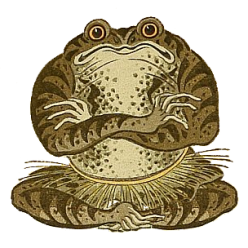One-third of all amphibian specied are in danger of extinction, according to a new report. In the future, mutant frogs will be the only ones that survive.
Category: Anura (frogs and toads)
Brazil sees profit in frog slime
Katukina says he possesses a treasure that could be at the cutting edge of biotechnology. If a plan initiated by the chief is successful, his tribe’s fortunes will be transformed by an asset that he and the Brazilian government say holds great promise for the global pharmaceutical industry: the slime from a poisonous tree frog.
Tribal shamans have used the slime as an ancestral remedy to treat illness, pain, even laziness. The crucial ingredients are compounds with anesthetic, tranquilizing and other medicinal properties.
Scientists say the promise lies in isolating peptides from the frog’s slime and then reproducing them for medicines to treat hypertension, stroke, and other illnesses
Cut off by floods, man survives on frogs
Wed Apr 5, 2006 09:37 AM ET
PRAGUE (Reuters)
– A Czech man ate frogs and other small animals for four days after he was trapped on an island cut off by flooding, the daily Pravo reported Wednesday.
Zdenek Bucek, 30, was taking a short-cut through the woods near the southeastern town of Breclav when a flood wave trapped him on a small patch of high ground.
Bucek was not carrying a cell phone and the water was too cold to swim through. To survive, he caught frogs and drank the floodwater until he flagged down an emergency crew passing by on a boat four days later.
“I had no idea a flood was coming. I had not even noticed that the forests were declared off limits,” he said.
Pravo said Bucek had matches, but did not elaborate on how he preferred his frogs.
Floods from rain and melting snow have killed at least six Czechs over the past week and forced thousands to flee their homes.
Rare Chinese frog uses ultrasonic communication
It may not be a mutant per-se, but it sure is an evolutionary rarity. From Reuters:
The frog, Amolops tormotus, is the first non-mammalian species known to use the ultra-high frequencies that humans cannot hear.
It comes in handy to be heard above the pounding waterfalls and streams in the mountainous region of east-central China where Amolops tormotus, which is known as the concave-eared torrent frog, lives.
Why the Frog Bridge is Stupid

Ampontan at Japundit had a thought-provoking post on the “Kaeru Hashi,” or Frog Bridge, that was built on central government largesse in Inami-cho, Wakayama Prefecture:
I can’t begin to explain how quintessentially Japanese this entire story is. They’ve managed to use a historical Japanese figure for inspiration, connect him to a unique public works project to gain a little recognition in a cheerful, positive way, and incorporate the Japanese love of wordplay. When I was new to the country, unaware of the extent to which I was affected–or infected–by the sense of fashionable, cynical irony so endemic in the West, I would have rolled my eyes until they slid out of their sockets at the dorky hellokittyishness of this bridge and the people who built it.
After all these years in Japan, however, I’ve come to realize that cynical irony is a dead end street and learned to appreciate the sincerity, simplicity, and earnestness of the emotion behind efforts such as those of the people of Inami-cho. I wish them the best, and if I’m ever in their neighborhood, I’ll be sure to stop by to look at the bridge and buy some vegetables or flowers. I’m sure they’re excellent. You can even see the bridge if you’re just passing through–they built it so that it’s visible from the local JR train station.
People at Japundit were too mesmerized by the hypnotic power of the bridge to respond to my comment, so here it is for my MF peoples:
You seem to present two possible interpretations of the Kaeru Hashi: cynical-ironic dismissiveness or appreciation for the earnestness of the people’s efforts.
Perhaps I haven’t spent enough years in Japan, but there must be at least one other way to look at something like this, because I think, with no irony whatsoever, that this bridge is a gaudy and horrible waste of money.
I mean, consider it this way: when you go into the house of a married couple and find that the wife keeps it decorated nook and cranny with frilly lace, pink bunnies, and countless antiques, scented with nostril-burning potpourri, and kept immaculately clean, do you (a) Appreciate the sincerity, simplicity, and earnestness of the emotion behind the woman’s efforts; or (b) Feel sorry for the poor schlep of a husband who has to put up with such tacky interior design (and probably isn’t allowed to sit on the couch)? I for one would choose (b). This bridge and other such projects look as if the federal government gave a team of domineering housewives with bad taste a million dollars to waste on whatever silly civil engineering project they could come up with.
That million dollars could have been put to much better use than yet another bridge. The problem is that the funds these towns get are tied to programs like the euphemistic “Self-conceived self-conducted Regional Development,” so they are forced to actually build something. If the federal government were truly interested in revitalizing these small towns (instead of padding the wallets of construction companies), they could have steered the money toward, just for example, scholarships to regional universities or maybe even incentive programs for industries.
The problem isn’t so much of different “worldviews” between the Japan and the “West” but rather one of the corrupt central government exploiting the small towns for its own benefit. It’s funny you call this post the “Great Leap Forward” because these types of federal programs actually do resemble China’s great leap forward in that they force local governments to perform economically unsustainable activities. The towns aren’t starving, at least, but without true economic development they are facing a slow death – depopulation. Koizumi’s “Trinity Reforms” are supposed to end the cycle of addiction to public works that afflicts the outlying regions of Japan by putting more tax revenue in their control, but prospects for their effectiveness are moderate at this point.
Eco life my style


Apparently last month Tokyo hosted the Eco-products 2005 trade show.

I’m sure they had a lot of interesting exhibits

but what really stands out for me is their mascot.
Police take on pirates in fake alien frog showdown
 Sorry, but it’s all downhill from the headline. It’s not that it’s a bad article exactly. Something about how the new Japanese cartoon Sergeant Keroro (ケロロ軍曹-main character pictured at left) has gotten so popular that toys modeled after the character are being bootlegged, and the anime downloaded illegally all over Taiwan and China. Ok, fine, interesting to know I guess-although seriously, by now wouldn’t you expect the same thing to happen with any even halfway popular cartoon show? I mean, after that headline I was really hoping for something with a little more juice than a story about toy pirates.
Sorry, but it’s all downhill from the headline. It’s not that it’s a bad article exactly. Something about how the new Japanese cartoon Sergeant Keroro (ケロロ軍曹-main character pictured at left) has gotten so popular that toys modeled after the character are being bootlegged, and the anime downloaded illegally all over Taiwan and China. Ok, fine, interesting to know I guess-although seriously, by now wouldn’t you expect the same thing to happen with any even halfway popular cartoon show? I mean, after that headline I was really hoping for something with a little more juice than a story about toy pirates.
Ah well. If you’re curious, you can download bootlegs of the show from this anime fansubs bittorrent site. I’ve seen a few minutes here and there on Taiwanese TV, and while I couldn’t really tell what was going on, what with it being in Chinese and all, it did look pretty funny.
Just a mutant frog.
Lou The White Frog Is A Connecticut Rarity
This frog was all white, with black eyes. Mr Taylor says, “We looked it up online and it didn’t seem too rare. Just a mutant frog.” Because it looked unique, though, the family kept it over the summer. The frog was set up in an aquarium habitat, where he spent most of his days resting on a rock near the water. Says Mrs Taylor, “We didn’t even think it would live.”
The white frog did live, however, and on a diet of crickets and mealworms that the Taylors bought for him and by September “Lou Albino” (named after the pro wrestling manager Lou Albano) had doubled his original size, to three inches.
More evidence that we are all doomed
This article is just over a year old, but I just stumbled across this article from National Geographic.
Invading Bullfrogs Appear Nearly Unstoppable
If that headline doesn’t chill you to the bone, you are a rock in these tumultuous times.
Frogstyle

I’ve had one of these hanging on my keychain for over three months now, but most of the green paint has been scratched off mine.
What is Frogstyle?
To people searching for happiness, to people feeling down, to people lacking something, frogs bearing a message for those sorts of people, that is FROG STYLE (furoggu sutairu). FROG STYLE has plenty of friends. When you see one on the street, please try getting a warm message from the frogs. Maybe, just maybe it will cheer you up!

Origin:
Once upon a time, the frog progenitor, the -ANCESTOR FROG- came from across the sea. (There are various stories, such as that he accidentally got stuck in ‘bottle mail’ and drifted across the waves.) Thereafter, FROG has been thriving all over the world. So far, 16 varieties have been identified. However, new types are continually being discovered. (From the book “Frog Life” by Frog researcher Kero Kaeruda)

Bandai’s Frogstyle screensaver is now the official screensaver of Mutantfrog.com.

Mac version here.


